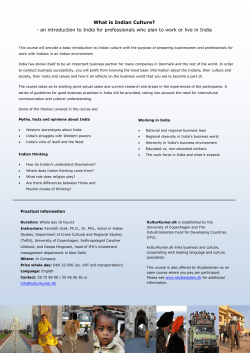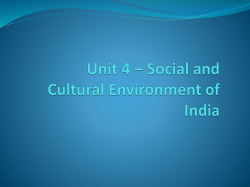
Yeh Kahan Aagaye Hum…..?*
1 Yeh Kahan Aagaye Hum…..?* By M. Vijaya Kumar 06 November, 2014 Countercurrents.org The Indian Left’s epic journey in to oblivion The Indian Left, with its glorious history of waging people’s struggles in the last 90 years, not withstanding its immense contribution to the political and cultural spheres, is today facing irreversible losses and what appears to be terminal decline. The Left’s role as leaders of mass movements and grass-roots mobilisations on people’s livelihood issues, is a thing of the past. It has lost the ability to wage people’s struggles on burning issues such as gross income and wealth inequalities, youth unemployment, drinking water, peasant struggles and such other critical issues. Its influence within the progressive intelligentsia is also on the wane. This has been repeatedly emphasized by many intellectuals sympathetic to the Left cause, but sadly, the leaders of the mainstream Left have become immune to the realities. Votes of Left parties: Lok Sabha elections 1952-2014 Year CPM CPI Seats Votes Seats Votes 2014 9 3.3% 1 0.8% 2009 16 5.3% 4 1.4% 2004 43 5.7% 10 1.4% 1999 33 5.4% 4 1.5% 1998 32 5.2% 9 1.7% 1996 32 6.1% 12 2.0% 1991 35 6.1% 14 2.5% 1989 33 6.5% 12 2.6% 1984 22 5.7% 6 2.7% 1980 37 6.2% 10 2.5% 1977 22 4.3% 7 2.8% 1971 25 5.1% 23 4.7% 2 1967 19 4.3% 23 5.1% 1962 29 9.9% 1957 27 8.9% 1952 16 3.3% The 2014 Indian General Elections have proved what has all the while been raised by the communist cadres and sympathizers outside the ranks of the Indian mainstream Left have been arguing – that the Indian Left Parties have swayed away from their course and are on a dangerous slide into a bottomless abyss. The leaders of the Left Parties have consistently ignored all appeals and well meaning suggestions. In fact, they have long back lost the ability to listen. As Com. Chaturanan Mishra wrote in 2009 about the follies of the Mainstream Left parties: “It was not only the slogan of building a ‘Third Front’ with the help of unprincipled regional political parties, many of them based on caste-lines. One does not know if the leaderships of the Communist Parties realise that when they go into one electoral battle in the company of one party and change it in the next election and again go back to the old party, educated, experienced and elderly people in general look upon the Communist Parties as opportunists.” “There is also the misconception in the leaderships about the Front itself. They think that the torjor** of the political parties is a Front. According to Marxist thinking as defined by the Seventh Congress of the Communist International, the concept of Popular Front is based on mass struggles and a common programme (which at that time had identified Hitler’s fascism as the main enemy). The present Third Front slogan given in this election has neither the background of joint mass struggles nor the commonness of a broad programme which should have created an alternative social and political block, capable of uniting all the people’s struggles taking place in different parts (and even with those who are not attached to any party but are against neo-imperialism) into one big torrent for political change as in Latin America. I think that not a single sustained statewide movement on any burning issue was launched by the Communists in the last twenty years.” (as on 2009) In the fight against oppression – the Left had lost its credibility The bland arguement of Com. Sitaram Yechuri, CPI(M) leader at the height of Singur protests in West Bengal, that globalisation is here to stay and the state governments, especially the ones run by the Left have no other recourse than following the capitalist policies of the Central government in 3 matters of economic policy where state governments have very little say. This is a lame excuse as the Left in India (that includes CPI(M), CPI, Forward Bloc, RSP, the Maoists as well as all other shades of red) have stopped talking about a socialist society that can replace the neo-liberal economy. The CPM had followed the Chinese path to build capitalism while they were in power in West Bengal. Mostly, we hear them talking about improvements to the present policies. The root cause of this is without doubt due a serious erosion of Marxist theory and practice in day-to-day struggles. We find very few leaders of the left parties in India who can combine theory with practice. Infact, in more than 3 decades of power in West Bengal and enjoying flip-flop power in Kerala, the Left Front headed by CPI(M) has failed to match the popular measures udertaken by many bourgeoisie Parties in Andhra Pradesh under YS Rajasekhara Reddy, MGR, Karunanidhi and Jayalalitha in Tamilnadu, among many others. In the recent parliament Elections, the middle classes have voted BJP to power on the premise that BJP has a strong leader and it will bring stability and development. This is largely a media creation and the middle class has been won over - though India's electoral system has given BJP 280 odd seats out of 542 with just 31% of the vote and 11% of the total voters have actually voted for BJP. The reason for the poor showing of Left is obvious. The villains are none other than the Left leaders themselves. They had abandoned class struggle and were busy with unprincipled election alliances with neoliberal minded bourgeoisie parties. They had put aside mass struggles and were busy lobbying with the government over benefits to middle peasants and aristocratic workers in organised sector. What is surprising is that even in the organised industrial sector, a majority of the workers are contract labour and the Left parties have marginal presence among them. They were busy lobbying for comparatively well paid regular workers. The workers in large industries are only interested in economic benifits and do not differentiate between BJP led union and Left led union. The feel they are middle class as they enjoy middle class incomes. 93% of India's workforce are in the unorganised sector, are poorly paid and live and work under appalling conditions. The Left parties have virtually abandoned them. In short, the Left in India had failed to understand and adapt to the realities of the changing times. In fact, in my 4 decades of participation in Left movements, I have seen the Left Party leaders increasingly succumbing to weaknesses of casteism and regional chauvinism. The recent bifurcation of Andhra Pradesh had amply demonstrated the deterioration that had set in CPI and CPI(M) on this issue. Some CPI leaders had given public statements about kicking the nearly 1 crore people of Rayala Seema and Costal Andhra regions who had settled for decades in Hyderabad and its environs, 4 as it was their capital city and the only source of employment and livelihood. One student leader of CPI was on record declaring that the ‘settlers’ should be driven out or massacred. For the first time in the history of any Communist Party anywhere in the world, the CPI had set a nefarious record of making enemies with the people of a whole region, what is now the decimated Andhra Pradesh. After all the show of regional chauvinism and fascist pronouncements, CPI in Telangana (and ofcourse in Andhra Pradesh) has been decimated in both the Parliament and Assembly elections of both the states. As Antonio Gramsci had said, when the old system is in its death throes and a new alternative system fails to materialize, then, all kinds of grotesque deformations of Capitalism, such as fascism and religious fanaticism will raise their head. This is exactly what we are witnessing after the recent Parliamentary elections. The BJP and its Sangh Parivar want to turn this country in to a Hindu country. Plans are being hatched to attack the minorities and Dalits and backward castes, in the name of “safeguarding Hinduism.” There is every danger that this dispensation holding power at the Center can rapidly deteriorate in to a fascist dictatorship. The pronouncements and action of BJP, RSS, VHP and other Sangh organizations are increasingly turning offensive, undermining the very foundations of secularism and democracy. The renewal of Indian Left – an urgent task The Indian Left, mainly the mainstream parties (CPI (M), CPI, ...) have to come out with alternatives (specific to India's conditions) to the neo-liberal economic system. Unless they do that, they will surely sink into the quagmire of ideological confusion and class compromise. Anyway, it not too late for the Indian Left to learn a few much needed lessons from the recent developments in West Bengal, Kerala and the rest of the country. This requires that we critically reconstruct an Indian path to socialism from below, abandon the reformist approach and understand that a revolutionary and democratic transformation of society can only be achieved by organized mass struggles of workers, agricultural labour and other oppressed peoples. Can the Left ever manage to combine parliamentary practice with active mass struggles? This has always been asserted in successive National Conferences of both the CPI and CPI(M), but largely abandoned in practice. The Left parties can reverse their decline and strengthen themselves only through candid selfcriticism and by returning to mass work over the coming years. The Left can see any hope only if it enunciates a clear revolutionary vision of social transformation by going back to the basic tenets of 5 Marxism, offers a radical alternative to neoliberal economic and destructive social policies to suit the present conditions, follow innovative and relevant political mobilisation strategies, and widens its appeal by participating in struggles on issues that deeply concern the toiling masses. To do this, the Left needs to update its analysis of Indian society and evolve a contemporary vision of development and relate this to its political programmes and policies. This calls for a number of changes, including a shift away from a literal belief in the inevitable development of the productive forces and the idea of a “two-stage” revolution. Equally necessary is a rejection of the presumed inevitability and intrinsic desirability of industrialisation, especially along the classical Western pattern, which can lead to slippage into an “industrialisation at any cost” position.1 Heavy industry is no longer a large scale employment generator. It is only through the creation of high-tech rural employment that we can solve the large scale unemployment that is facing the youth, like an elephant in the room. In India, today only 20% of professional graduates are able to get some sort of employment, that to at ridiculously low wages. The position of graduates is much worse. Only 10% among the can hope to get some job. But the fact is that a developing country such as India has a very small formal sector. About 92% of the workforce is employed in the informal sector, with little or insignificant impact of modern technologies. The increased precariousness of their jobs, often as contract jobs, makes it ever harder for them to seek improvements in their pay and working conditions; it in fact degrades the living conditions day by day. Agriculture in the developed economies is based on capitalist methods and it is increasingly unsustainable. Anyway, hardly 2% of the total workforce is engaged in agriculture in these countries and the profits are captured by multinational corporations. The ruling class in India wants to introduce similar capitalist agricultural practices and want to drive out 50% of India’s population away from agriculture and drive them to cities. Imagine what kind of a catastrophe awaits us if 50% of India’s population are deprived of their land and thrown into cities! Latin America and Europe: A Resurgent Left? 6 As it was emphasized above, all is not lost. We can learn from the experiences and victories of the Left forces in Latin Ameruica and Europe and struggle for a revival of Left in India: The unprecedented rise to political power of 11 left-leaning governments in Latin America in the last 20 years is a significant political development, post Soviet Collapse. Three dimensions of leftism are particularly relevant: rejection of neoliberal economic policies; responsiveness to social movements demanding economic and social benefits for the poor and excluded; and defense of national independence and continental solidarity in opposition to the hegemony of the United States. The Latin American Left embraces a broad spectrum of political positions, and has offered a variety of responses, in challenging the failed policies of neo-liberalism. Radical Left Results, 2009-2014 European Parliament Elections The radical European left could become the third force in the European Parliament, after the conservatives and social democrats, according to recent polls. In Greece the radical left soared to 33.82% of valid votes. In Spain the radical left rose to 20.78% and 20.96% in Portugal. The Front de Gauche in France had secured 8.2% and Die Linke in Germany 7.57%. We have to understand that this has become possible only when the various Left factions and the Communist Parties, putting aside their differences had come together and waged common struggles. Intellectuals and the Communist Party Today, many Leftist intellectuals are disillusioned with the Communist Parties. It is no exaggeration to say that there are more communists outside of the communist parties than inside. The need to develop a theoretical base is imperative and this role has to be fulfilled by Leftist intellectuals and the Party has to put up renewed efforts to attract and retain them. Antonio Gramsci made a clear distinction between 'traditional' and 'organic' intellectuals: 'traditional' intellectuals are those that show little interest in socoal and political issues. 'Organic' intellectuals, on the other hand, speak for the interests of a specific class. Gramsci is interested in the formation of intellectuals who will be organic to the interests of the working class (and who therefore find their place within the revolutionary party). The working-class needed to develop a culture of its own, which would overthrow the notion that bourgeois values represented 'natural' or 'normal' values for society, and would attract the oppressed 7 and intellectual classes to the cause of the proletariat. Gramsci’s ideas were based on Marx’s notion of false consciousness, a state in which individuals are ideologically blinded to the domination they suffer. Simply, the masses can be duped into buying into a system which exploits them. If the working class wants to succeed in becoming hegemonic, it must also create its own intellectuals to develop a new ideology. Conclusion The necessity for a new kind of Left is all the more pertinent in the present situation, what with the reactionary and communal forces winning the reins of power. There will surely be an intensification of struggles against oppression and the tyranny of big capital. In most of the struggles that had taken place in the recent past, the Left was conspicuous by its absence. The possibility of the emergence of newer formations and coalitions in the coming days, need to be kept open. Those who have steered the Left so far failed to show any vision; now they have lost all credibility as well. If the present attitude of the Left leaders continues in the same fashion, there is every danger that the Left as a force will disappear from the Indian political scene. There is an urgent need to reinvent a new Left. This must be done on a firmly Marxist foundation. I want to conclude with an oft cited quotation of Prof. Micheal Lebowitz: In the famous book, ‘Alice in Wonderland’, the Chechire Cat tells Alice,”If you don’t know where you have to go, any road will take you there.” But Lebowtz says, “in the case of Marxists, if you don’t know where you have to go, no road will take you there!” The Left in India has to reinvent itself, shedding old outdated concepts and age-old biases and evolve a new culture of openness and active dialogue with the toiling masses. We have to have a vision about our goals and program. Otherwise, NO ROAD will take us to our goal. Notes: * - Literally translates in to “What destination we have reached” – taken from a Hindi song by Lata mangeshkar in the film “Silsila.” ** - Tor-Jor (Hindi) means unprincipled and opportunistic alliances. 8 Note: The recent announcement of the Left Parties that they will work together is a welcome development. But sadly, the inflated egos of Left Leaders kill all such initiatives in the budding stage itself. We have seen how the very next day of making announcement of united struggles, the Leaders of CPM and CPI indulge in ugly fracas, severely jeopardizing any effort at united action. Let us hope against hope, it will be different this time. References 1. Challenges for the Left in India - Praful Bidwai, Frontline, Volume 29 - Issue 18, 4 September 2012 2. The Disappeared Left and a Possible Future Left: Aditya Nigam, Kafila, May 25, 2014 3. 4. Can the Left recover from its election debacle?; Parful Bidwai, DNA, 26 June 2014 Rebuilding the Left and Renewal of Socialism - Chaturanan Mishra, Mainstream, Vol XLVII, No 25, June 6, 2009 About the author: Vijaya Kumar Marla is a retired Engineer from BHEL, Hyderabad and holds a PG Degree in Power Systems Engineering and is a consultant for renewable energy projects. His subject of interest is “Philosophy of Science and Technology,” and is presently working on the subject, “Marxism and Modern Science.” E-Mail: marlavk@yahoo.com
© Copyright 2025














